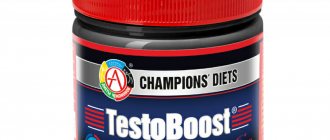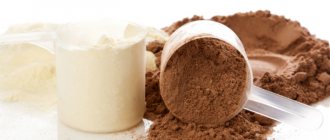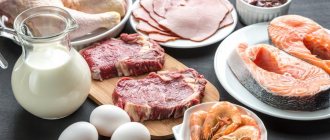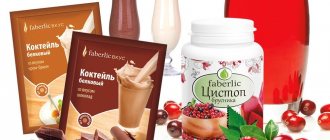Remember to get enough protein
When reducing body fat while maintaining muscle tissue, it is important to ensure adequate protein intake. Protein is one of the most important nutrients and is important in burning fat for several reasons [15]:
- They change hormone levels - proteins increase levels of "satiety" hormones such as GLP-1, YY-peptide and cholestokinin , while reducing levels of ghrelin , which is a hunger hormone .
- have a stronger thermogenic effect - after eating, some of the calories are used to digest food, this process is known as the thermogenic effect. Proteins have a stronger thermogenic effect than fats or carbohydrates. Approximately 20-30% of calories from protein are burned during digestion and protein metabolism.
- you burn more calories - a stronger thermogenic effect and other facts are the reason why higher protein intake speeds up your metabolism during the day and even sleep. Several studies have shown that higher protein intake causes us to burn 80-100 more calories per day.
Research shows that protein should make up 30% of your daily caloric intake . This fact is confirmed by the results of a study involving overweight men. When protein made up 25% of their daily caloric intake , thoughts about food decreased by 60% , and the desire to eat something harmful in the evening decreased by 50% . Participants in another study consumed 30% protein as a proportion of their daily calorie intake. According to the results, they consumed 441 calories per day and lost 5 kg in 12 weeks. Are you interested in the research results and want to better understand protein gram ratios ? If you take in 2,000 calories a day, 30% of that is about 150 grams of protein. You can easily calculate the appropriate protein content by multiplying your daily calorie intake by 0.075. [3]
Eating protein is not only important during the day, our digestive system also works at night , and in order to maintain muscle mass, we need to prevent hunger and cramps . You can help keep your hunger at bay at night by taking a slow-digesting protein like casein, for example. It is characterized by low carbohydrate content, high protein content, as well as calcium , which is necessary for the production of melatonin, which promotes sleep. The body uses it as energy , so you don't have to worry about it being stored in the body as fat. [2] Want to learn more about a lesser-known source of protein? Read our article – Casein, casein proteins and everything you need to know about them.
Cinnamon
Many people like the sweet, enveloping taste of cinnamon. Studies have shown that cinnamon helps normalize blood sugar levels. Stable blood sugar levels will curb cravings and slow the release of energy over time.3
Generalization
Even if you include all the foods listed above in your diet, if you do not provide yourself with a calorie deficit, you will not be able to achieve results and burn excess fat. More sustainable fat loss and healthier habits that will last a lifetime come from exercising regularly and maintaining habits over time. Drastically cutting calories and temporarily following a healthy lifestyle will not yield results.
You can achieve greater fat burning faster if you combine your diet with fat-burning workouts.
Conclusion
By choosing foods high in fiber, water, vitamins and minerals, you can help combat hunger and provide your body with the nutrients it needs to optimize your metabolism. Over time, your body will burn more fat.
Articles on our website are presented for educational and informational purposes only. We do not recommend using article materials as medical advice. If you decide to take dietary supplements or make fundamental changes to your diet, first consult with a specialist.
Translation: Farida Seidova
Beware of drastic reductions in calorie intake
You may think it makes sense to drastically cut your calorie intake to achieve a reduction in fat percentage, but this decision will lead to a completely different result . This method of eating is very close to a hunger strike, and the lack of energy in the diet forces the body to obtain energy from muscle tissue. In addition to muscle breakdown, intake of vitamins and other nutrients will be significantly reduced, leading to poor muscle regeneration after exercise. Drastically cutting calories will make you feel hungry, you will become impatient , and you will constantly think about food . Hunger is not the only problem that arises when there is a sudden and drastic reduction in daily caloric intake. Such diets also lead to [1] [3] [4]:
- slow metabolism
- poor sleep quality
- lethargy, fatigue
- water retention in the body
- decreased libido and reproductive functions
When reducing your calorie intake, it is important that it does not “shock” your body . Start moderately reducing your calorie intake, preferably reducing your calorie intake by 200-500 kcal. [1]
Keep drinking regime
Liquid can reduce hunger and will fill your stomach, thereby prolonging your feeling of fullness. A 2014 study found that drinking 0.5 liters of water about 30 minutes before breakfast, lunch and dinner reduces hunger and therefore overall weight. Sufficient consumption of water ensures, among other things, the flushing of harmful substances from the body , supports kidney function, and also restores the digestive system . It is also important for the metabolism of fats and carbohydrates . The process of digesting fats is called lipolysis , and in the first stage, water molecules act on triglycerides, which break down into glycerol and fatty acids. Another reason for hydration for athletes and active people is its effect on the functionality and mobility of cartilage . In addition, water is important for the proper functioning of the lungs, heart and other organs, reducing fatigue and muscle spasms. [5]
Are you trying to increase your water intake throughout the day, but don't know how? [6]
- Carry a bottle with you and top it up with water regularly.
- Place a full glass of water on your desk.
- Always have a glass of water by your bed to drink at night or in the morning.
- Replace a glass of sugary or carbonated drink with a glass of water.
- Try drinking more than six glasses of water throughout the day.
Don't overdo your cardio workouts
Have you decided to add more running or cycling to your training plan? An increased emphasis on cardio can trigger a sequence of reactions that affect the maintenance of muscle mass . More cardio means less time to regenerate , and therefore it can very easily happen that the body does not have enough time to recover at all. As a result, strength and performance will not increase , which is due to the ability to build and maintain muscle mass while reducing fat percentage. Too much cardio also leads to overtraining, injury, fatigue and mood swings. Running is a suitable exercise in a reasonable amount, but too much increase in cortisol levels negatively affects the immune system . Frequent increases in cortisol levels also affect fat burning and muscle loss . [4] [7] [8] Do you think overtraining is a myth and want to know more? Read our article – Overtraining – Fact or Myth?
It's difficult to determine how much cardio is too much because it depends on several factors, such as frequency, intensity, or duration . Walking can be a suitable activity for burning fat and maintaining muscle mass. A 30-90 minute walk will help you burn fat without significantly affecting your body's regeneration. [4]
How to burn subcutaneous fat: recommendations
The beginning of losing excess weight begins in the kitchen, you need to pay close attention to nutrition, if this is not done, any of the most effective exercises will not bring significant benefits.
It is necessary to determine the reason for the initial gain of excess weight in order to get rid of it in the opposite way.
To achieve this goal, it is necessary:
DETERMINE THE TYPE OF FAT - if the goal is to get rid of a round belly, which is caused by fat located deep inside the body, you need a long-term diet, cardio exercise, increased protein intake and, of course, time to restore the body.
DON'T EXPECT A MIRACLE FROM PRESS TRAINING – abdominal exercises are aimed at strengthening the abdominal muscles; muscle definition depends on nutrition and cardio exercise. If you neglect nutrition and train your abs regularly, in a variety of ways, and with all the basics of technique, you will have it, but under a layer of fat.
START EATING DIFFERENTLY - proper nutrition with a balanced diet of proteins, carbohydrates and fats will ensure faster achievement of the final result. Always remember that a flat stomach is 70% dependent on nutrition and only 30% on exercise.
DON'T THINK OF LOSSING WEIGHT IMMEDIATELY - many people want to lose weight quickly and do little to do it; the desire is good, but unlikely without harm to health. The idea is to lose 400-600 grams per week. fat is disappointing, but in a year this figure in total, if necessary, can be 20 - 30 kg. and that's just fat!
Not counting the lost water and still a small loss of muscle mass. Remember how many years you have accumulated fat, now give your body time to get rid of it.
Be careful with carbohydrates
The content of carbohydrates in the diet also influences the adequate reduction of body fat and preservation of muscles Excessive consumption of carbohydrates contributes to their conversion into fat and storage in the body, but a sharp reduction in carbohydrate consumption is also not the right solution . Excessively low carbohydrate intake is not necessary for weight loss, as it can lead to uneven muscle tissue retention and decreased performance during training. A 2003 study confirmed the effect of carbohydrates on reducing fat percentage and preserving muscle. Participants followed a 10-week plan during which they consumed 1,700 calories per day . They were divided into two groups, the first of which consumed carbohydrates and protein in a 1.4:1 ratio , for example, 125 g protein and 171 g carbohydrates . The second group consumed 3.5 times more carbohydrates relative to protein , which is approximately 437.5 g of carbohydrates and 125 g of protein . The results showed that the first group lost more fat and less muscle mass than the second. [8]
You can also achieve the desired result using a less complex ratio. The ideal ratio of carbohydrates to protein for preserving muscle and reducing fat percentage is 2:1 . For example, with a daily intake of 125 g of protein, the amount of carbohydrates is 250 g . in certain cases , namely for athletes and people who train hard, but is not important for the average person. Determining the ideal time to burn fat is difficult because research results vary so much . During the day, it is important to take carbohydrates in the morning to provide energy for daily activities and after exercise to replenish energy and nutrients . The most important factor is the source of carbohydrates , so complex carbohydrates containing fiber , such as oatmeal, are preferred. Your overall carbohydrate intake is more important than the exact timing of your carbohydrate intake unless you are training for a competition. If you eat carbohydrates in moderation, you don't have to worry about timing them. [8] [2] [14] Looking for the perfect breakfast dish to fill up your carbs and protein ? 15 grams of protein and 53 grams of carbohydrates this instant oatmeal is an excellent choice.
Chronic obstructive pulmonary disease
Chronic obstructive pulmonary disease (COPD) is an environmentally mediated chronic inflammatory disease with predominant damage to the distal respiratory tract, lung parenchyma and the formation of emphysema, which is characterized by the development of first partially reversible and ultimately irreversible bronchial obstruction.
COPD, as a rule, is a primarily chronic disease that develops in predisposed individuals and is characterized by a long, steadily progressive course resulting in chronic respiratory failure and cor pulmonale.
The main etiological factor leading to the development of COPD is smoking (active and passive), as well as prolonged exposure to occupational irritants. The action of etiological factors leads to disruption of mucociliary clearance, resulting in mucostasis and obstruction of small bronchi. Damage to the bronchial mucosa is accompanied by an increase in the tone of the vagus nerve and, as a result, an increase in the bronchospastic reaction. At the same time, neutrophils migrate into the lungs, which leads to an imbalance of protease/antiprotease. The predominance of proteolytic activity leads to the destruction of the structural elements of the alveoli and the development of emphysema.
The main clinical manifestations of COPD are cough, expiratory shortness of breath, and the presence of difficult to separate sputum (mucous, and in case of exacerbation, purulent). For a long time, COPD occurs without pronounced clinical manifestations. Exacerbation of COPD is manifested by a worsening of all symptoms and the appearance of purulent sputum. As COPD progresses, the intervals between exacerbations become shorter, and clinical manifestations in remission become more pronounced.
Currently, a classification of COPD has been adopted, in which the main indicator of the severity of the disease is the FEV1 value:
- Mild course: FEV1/FVC<70%, FEV1≥80% of the required values, there is a chronic cough and sputum production, but not always.
- Moderate course: FEV1 /FVC < 70%, 50% ≤ FEV1 < 80% of the required values, there is a chronic cough and sputum production, but not always.
- Severe course: FEV1/FVC < 70%, 30% ≤ FEV1 < 50% of the required values, there is a chronic cough and sputum production, but not always.
- Extremely severe: FEV1/FVC < 70%, FEV1 < 30% of predicted values, or FEV 1 < 50% of predicted values in combination with respiratory failure or right ventricular failure.
The diagnosis of COPD is considered reliable in the presence and combination of the following signs:
- risk factors
- clinical manifestations, the main of which is expiratory dyspnea
- steadily progressing impairment of bronchial obstruction, assessed by spirometry
- the absence of other diseases that can lead to similar symptoms.
The basic principle of treatment: a stepwise increase in the volume of therapy depending on the severity of the disease. Non-drug treatment includes eliminating risk factors (smoking cessation), oxygen therapy in patients with respiratory failure, and rehabilitation programs. Pharmacotherapy is carried out with bronchodilators, which are the basis for the symptomatic treatment of COPD (M-anticholinergics, short- and long-acting B2-adrenergic agonists, long-acting methylxanthymes, combination drugs), as well as mucolytics, antibiotics for exacerbation of COPD, etc. If necessary, surgical treatment is performed: bullectomy , lung transplantation.
Don't forget about amino acids
Branched chain amino acids are beneficial for maintaining muscle mass as well as reducing fat percentage. BCAA is an acronym for the three essential amino acids leucine, isoleucine and valine , which are the main building blocks of muscle . They make up about a third of muscle protein and are used by the body to repair muscle fibers . With a reduced calorie intake, the body receives fewer nutrients for proper regeneration . BCAA may promote tissue repair during this process, thereby promoting protein synthesis for muscle recovery after exercise. According to a 2021 study, consuming 5.6 g of BCAA has a significant effect on protein synthesis . A group of participants who consumed BCAAs after strength training experienced a 22% increase in protein synthesis . Other studies conducted in 2012 and 2014 looked at changes in protein synthesis in people who took whey protein containing BCAA . Results showed a 50% increase in protein synthesis , indicating that BCAAs are important but are most effective when consumed by other amino acids found in protein. Another benefit is that they are low in calories, so you don't have to worry about increasing your calorie intake. A 2012 study demonstrates their importance for maintaining muscle mass and strength . The results show their main benefit in reducing muscle mass and improving the regeneration of muscle function. [9] [10] [11]
All the necessary information about BCAA amino acids and their importance for the body can be found in the article - The effect of BCAA on the body.








